The Fundamentals of Digital
Semiconductor Testing
Guy Perry
Soft Test Inc.
246 Union Avenue
Los Gatos, California 95032
USA
Phone (408) 377-1888 Fax (408) 377-1866 Www.soft-test.com
Version 2.03 - September 1999 ISBN # 0-9658797-0-4
No part of the document may be copied, reproduced, stored in a retrieval system or transmitted, in
any form or by any means, without the prior written consent of Soft Test Inc.
Copyright © 1995 - 1999 Soft Test Inc. All Rights Reserved
The Fundamentals of Digital Semiconductor Testing
1
�
Preface
This manual has been created to provide a detailed understanding of the concepts of digital
semiconductor testing of CMOS and TTL technologies using ATE test equipment. A brief overview of
semiconductor manufacturing and the peripheral equipment used in production testing is also
included.
The text presents procedures and guidelines for engineers to follow which will insure quality and
reliability when creating or modifying test programs. Techniques are also included which will increase
productivity and reduce the need for test system time.
To get the most out of this material the reader must have an understanding of basic electronics and
digital circuits. If you need help in this area a short refresher can be found in Section One. The training
class associated with this text presents a forum for questions, concerns, ideas and general
discussions related to digital semiconductor testing.
I truly hope this information will help you to understand digital component testing and perhaps make
your job a little easier.
Sincerely, Guy Perry
The Fundamentals of Digital Semiconductor Testing
2
�
Table of Contents
Chapter 1 The Basics ........................................................................................................................................ 1-1
Objectives ................................................................................................................................................................................... 1-1
Scientific / Engineering Notation ............................................................................................................................................. 1-1
Voltage ........................................................................................................................................................................................ 1-2
Current ........................................................................................................................................................................................ 1-2
Resistance .................................................................................................................................................................................. 1-2
Using Ohm's Law to Test Device Specifications................................................................................................................... 1-3
Digital Numbers.......................................................................................................................................................................... 1-6
Digital Logic ................................................................................................................................................................................ 1-8
Chapter 2 Overview of Semiconductors and ATE ......................................................................................... 2-1
Objectives ................................................................................................................................................................................... 2-1
ATE - Automated Test Equipment .......................................................................................................................................... 2-5
Semiconductor Technologies................................................................................................................................................... 2-5
Digital and Analog Circuits ....................................................................................................................................................... 2-6
Types of ATE Systems ............................................................................................................................................................. 2-7
Tester Loadboards .................................................................................................................................................................. 2-11
Wafer Probing .......................................................................................................................................................................... 2-12
Probe Cards ............................................................................................................................................................................. 2-14
Device Handlers....................................................................................................................................................................... 2-15
Temperature Forcing Units..................................................................................................................................................... 2-16
Chapter 3 Introduction to Test ........................................................................................................................ 3-1
Objectives ................................................................................................................................................................................... 3-1
Basic Terms................................................................................................................................................................................ 3-1
What is The Correct Way to Test?.......................................................................................................................................... 3-2
The Test System........................................................................................................................................................................ 3-4
The PMU..................................................................................................................................................................................... 3-6
The Pin Electronics.................................................................................................................................................................. 3-11
Basic Rules of Test Engineering ........................................................................................................................................... 3-14
Chapter 4 Device Specifications....................................................................................................................... 4-1
Objectives ................................................................................................................................................................................... 4-1
Basic Terms................................................................................................................................................................................ 4-1
The Design Specification.......................................................................................................................................................... 4-1
The Test Specification .............................................................................................................................................................. 4-2
The Device Specification .......................................................................................................................................................... 4-2
Test Conditions and Limits....................................................................................................................................................... 4-2
Parameters that Apply to Parametric Testing (DC) .............................................................................................................. 4-2
Parameters that Apply to Functional and AC Testing .......................................................................................................... 4-3
Logical Functions....................................................................................................................................................................... 4-3
Reading Device Specifications ................................................................................................................................................ 4-3
256 x 4 RAM Specifications ..................................................................................................................................................... 4-5
Interpreting the Device Specification ...................................................................................................................................... 4-8
Device Specifications and Test Conditions.......................................................................................................................... 4-10
Chapter 5 Opens and Shorts - PMU Method.................................................................................................. 5-1
Objectives ................................................................................................................................................................................... 5-1
Why Test for Opens and Shorts?............................................................................................................................................ 5-1
Opens and Shorts Serial Static Method ................................................................................................................................. 5-1
Chapter 6 Verifying DC Parameters ............................................................................................................... 6-1
Objectives ................................................................................................................................................................................... 6-1
Basic Terms................................................................................................................................................................................ 6-1
Binning ........................................................................................................................................................................................ 6-2
Program Flow ............................................................................................................................................................................. 6-3
Test Summary............................................................................................................................................................................ 6-4
DC Tests and the Hidden Resistance .................................................................................................................................... 6-5
Ohm's Law.................................................................................................................................................................................. 6-5
VOH/IOH..................................................................................................................................................................................... 6-7
VOL/IOL .................................................................................................................................................................................... 6-11
IDD Gross Current................................................................................................................................................................... 6-15
The Fundamentals of Digital Semiconductor Testing
3
�
IDD Static Current.................................................................................................................................................................... 6-19
IDDQ.......................................................................................................................................................................................... 6-22
IDD Dynamic Current.............................................................................................................................................................. 6-23
Input Currents (IIL/IIH) ............................................................................................................................................................ 6-27
Resistive Inputs—Pull-ups and Pull-downs ......................................................................................................................... 6-34
Output Fanout .......................................................................................................................................................................... 6-35
High Impedance Currents (IOZL/IOZH) ............................................................................................................................... 6-37
Input Clamp (VI)....................................................................................................................................................................... 6-42
Output Short Circuit Current (IOS)........................................................................................................................................ 6-45
Chapter 7 Verifying Functional Parameters .................................................................................................. 7-1
Objectives: .................................................................................................................................................................................. 7-1
Basic Terms.............................................................................................................................................................................. 7-12
Functional Testing ................................................................................................................................................................... 7-12
The Test Cycle ......................................................................................................................................................................... 7-13
Input Data ................................................................................................................................................................................. 7-14
Input Signal Formats ............................................................................................................................................................... 7-15
Output Data .............................................................................................................................................................................. 7-18
Testing Outputs........................................................................................................................................................................ 7-18
Developing Output Strobe Timing ......................................................................................................................................... 7-23
Vector Data............................................................................................................................................................................... 7-26
Executing a Functional Test................................................................................................................................................... 7-26
Functional Specifications........................................................................................................................................................ 7-27
Gross Functional Tests........................................................................................................................................................... 7-28
Equation Based Timing........................................................................................................................................................... 7-29
Functionally Testing a Device................................................................................................................................................ 7-30
Sample Device Specification ................................................................................................................................................. 7-30
Specification Test Conditions for the Clocked Inverter ...................................................................................................... 7-34
Gross Functional Test Conditions for the Clocked Inverter............................................................................................... 7-34
Test Program Statements for Clocked Inverter................................................................................................................... 7-36
Standard Functional Tests ..................................................................................................................................................... 7-37
Opens and Shorts - Functional Method................................................................................................................................ 7-37
VIL/VIH ...................................................................................................................................................................................... 7-42
VOL/IOL VOH/IOH Functional Test ...................................................................................................................................... 7-45
Resistive Output Loading ....................................................................................................................................................... 7-48
Functional Z–State — High Impedance Testing ................................................................................................................. 7-50
Open Drain / Open Source Outputs...................................................................................................................................... 7-53
Chapter 8 Testing AC Parameters................................................................................................................... 8-1
Objectives: .................................................................................................................................................................................. 8-1
AC Parametric Testing.............................................................................................................................................................. 8-1
Read & Record........................................................................................................................................................................... 8-1
Go-Nogo Testing........................................................................................................................................................................ 8-1
Compromises ............................................................................................................................................................................. 8-2
Standard AC Parameters ......................................................................................................................................................... 8-2
Setup Time ................................................................................................................................................................................. 8-3
Hold Time.................................................................................................................................................................................... 8-4
Propagation Delay Measurements.......................................................................................................................................... 8-5
Minimum Pulse Widths ............................................................................................................................................................. 8-6
Maximum Frequency................................................................................................................................................................. 8-7
Output Enable Time .................................................................................................................................................................. 8-8
Output Disable Time.................................................................................................................................................................. 8-9
AC Specifications from 256 x 4 Static RAM Data Sheet.................................................................................................... 8-10
Developing Functional Timing ............................................................................................................................................... 8-11
Write Cycle Timing .................................................................................................................................................................. 8-12
Read Cycle Timing .................................................................................................................................................................. 8-13
Chapter 9 Device Characterization ................................................................................................................. 9-1
Objectives: .................................................................................................................................................................................. 9-1
Test Vectors and Characterization.......................................................................................................................................... 9-1
The Binary Search..................................................................................................................................................................... 9-1
Binary Search Test Applications ............................................................................................................................................. 9-2
The Linear Search ..................................................................................................................................................................... 9-3
The Fundamentals of Digital Semiconductor Testing
4
�
Common Characterization Parameters .................................................................................................................................. 9-3
The Test System Datalogger ................................................................................................................................................... 9-5
Use of Test System Tools ........................................................................................................................................................ 9-5
Shmoo Plots ............................................................................................................................................................................... 9-6
Threshold/Level Search............................................................................................................................................................ 9-8
Chapter 10 Test Vector Development............................................................................................................ 10-1
Objectives: ................................................................................................................................................................................ 10-1
Test Vectors ............................................................................................................................................................................. 10-1
Example Vector File ................................................................................................................................................................ 10-1
Working with the Design Engineer........................................................................................................................................ 10-2
Creating Vectors by Hand ...................................................................................................................................................... 10-2
Tester Options (Memory Considerations) ............................................................................................................................ 10-3
Test Vector Examples............................................................................................................................................................. 10-3
Simulation Data........................................................................................................................................................................ 10-7
Simulation for Test................................................................................................................................................................... 10-9
Chapter 11 Test Program Development Issues............................................................................................. 11-1
Objectives: ................................................................................................................................................................................ 11-1
What is the Primary Purpose of the Test Program?........................................................................................................... 11-1
Other Considerations .............................................................................................................................................................. 11-2
Initializing the Program ........................................................................................................................................................... 11-2
Verifying the Test Setup ......................................................................................................................................................... 11-2
Power-on Sequencing............................................................................................................................................................. 11-3
Power-off Sequencing............................................................................................................................................................. 11-4
Chapter 12 Creating a Test Program ............................................................................................................ 12-1
Objectives: ................................................................................................................................................................................ 12-1
Developing the Test Plan from the Device Specification................................................................................................... 12-1
Designing the Test Hardware ................................................................................................................................................ 12-2
Writing the Test Program........................................................................................................................................................ 12-2
Loadboard Tests...................................................................................................................................................................... 12-3
Tester Diagnostics................................................................................................................................................................... 12-4
Running the Program the First Time..................................................................................................................................... 12-4
Verifying the Functional Test Setup...................................................................................................................................... 12-4
A Brief Discussion on Test Vectors....................................................................................................................................... 12-5
Chapter 13 Troubleshooting........................................................................................................................... 13-1
Objectives ................................................................................................................................................................................. 13-1
Where to Begin ........................................................................................................................................................................ 13-2
Example: IIL/IIH Test Failures ............................................................................................................................................... 13-4
Debug Tools ............................................................................................................................................................................. 13-5
Chapter 14 Qualifying and Documenting the Test Program ...................................................................... 14-1
Objectives ................................................................................................................................................................................. 14-1
Qualification.............................................................................................................................................................................. 14-1
Verify testing on handlers and probers................................................................................................................................. 14-2
Documenting the Test Program............................................................................................................................................. 14-2
Chapter 15 CMOS Device Latch-up.............................................................................................................. 15-1
Objectives: ................................................................................................................................................................................ 15-1
What is Latch-up?.................................................................................................................................................................... 15-1
Latch-up Testing ...................................................................................................................................................................... 15-3
Test Patterns ............................................................................................................................................................................ 15-4
Test Procedure Summary....................................................................................................................................................... 15-5
Applying Test Stimulus ........................................................................................................................................................... 15-6
Chapter 16 Principles of Scan Testing .......................................................................................................... 16-1
Objectives: ................................................................................................................................................................................ 16-1
What is Scan Testing? ............................................................................................................................................................ 16-1
LSSD Technique...................................................................................................................................................................... 16-4
Scan Test Equipment.............................................................................................................................................................. 16-4
Glossary................................................................................................................................................................. 1
Answers to Review Questions.............................................................................................................................. 1
Section 3 - Introduction to Test................................................................................................................................................... 1
Section 4 - Workbook Exercise .................................................................................................................................................. 2
The Fundamentals of Digital Semiconductor Testing
5
�
Section 4 - Device Specification................................................................................................................................................. 3
Section 5 - Opens and Shorts..................................................................................................................................................... 4
Section 6 - DC Tests .................................................................................................................................................................... 5
Section 7 - Functional Test.......................................................................................................................................................... 8
Section 8 - AC Testing............................................................................................................................................................... 11
Section 9 - Device Characterization......................................................................................................................................... 12
Section 10 - Test Vector Development.................................................................................................................................... 13
Section 11 - Test Program Development issues.................................................................................................................... 14
Section 12 - Creating a Test Program..................................................................................................................................... 16
Section 13 - Troubleshooting.................................................................................................................................................... 17
Section 14 - Qualifying and Documenting the Test Program............................................................................................... 19
The Fundamentals of Digital Semiconductor Testing
6
�
Chapter 1 The Basics
Objectives
This section explains:
* Number formats
* What is: Voltage, Current, Resistance
* Various methods to measure resistance
* Digital Logic Pulses
* Simple Digital Circuits
This section is intended to be a short refresher for those who have not used their electronics training recently. It is not,
however, intended to be a replacement for a complete basic electronics course.
Scientific / Engineering Notation
It may be necessary to express very large numbers or very small numbers when dealing with test issues. To simplify
writing these numbers they are often expressed in scientific notation format. This format uses the mathematical properties of
the powers of 10. In engineering texts and writing, abbreviations are used to represent levels of 1000. The following table
shows the scientific notation, the computer notation, the abbreviation and names for commonly used numbers in the test
industry.
Number
1,000,000,000
1,000,000
1,000
10
1
.1
.001
.000001
.000000001
Name
Giga
Mega
Kilo
Deka
Unity
Deci
Milli
Micro
Nano
Computer
Notation
10E+9
1E+6
1E+3
1E+1
1E+0
IE-1
IE-3
IE-6
IE-9
Power of 10
Equivalent
1x109
1x106
1x103
1x101
1x100
1x10-1
1x10-3
1x10-6
1x10-9
Abbreviation
G
M
K
da
d
m
µ(u)
n
The Fundamentals of Digital Semiconductor Testing
1-1
�
Voltage
Voltage is the electrical difference of potential between two points. In a power supply the negative terminal has
an accumulation of negative charge (a surplus of electrons), while the positive terminal has a positive charge
(an accumulation of positive ions). This potential difference can be measured as voltage. "V" is the unit
abbreviation for voltage, as in 5.0V (named for Alessandro Volta, an Italian physicist who first measured it).
You sometimes create a voltage, called static electricity, when you walk across a carpet in a room with dry air.
The formula symbol for voltage is E, short for EMF, short for ElectroMotive Force (which is probably what Volta
called it). Some texts also use "V" as the formula symbol for voltage.
Current
Current is the flow of charge through a conductor. If a conductor (e.g., copper wire) is connected between the
positive and negative terminals of a power supply, current will flow in an effort to balance the potential
difference (the voltage) between the two points. This flow can be measured and is described in units called
amperes or amps (named for Andre M. Ampere, a French physicist and contemporary of Volta who studied
electricity). "A" is the unit abbreviation for current, as in 2.5mA (milliAmps). "I" is the formula symbol for
current.
Resistance
Resistance is the opposing force to current flow, similar to friction which opposes mechanical force. The unit of
measurement used to describe the amount of resistance a material offers is the ohm, (named after George
Simon Ohm, a German physicist who did research on electricity). The unit abbreviation for ohm is the Greek
letter omega (Q). The formula symbol for resistance is R, for the obvious reason.
Different materials have different amounts of resistance. The table below shows the typical resistance found in
one foot of
Material
Silver
Copper
Gold
Aluminum
Nickel
Iron
Carbon
Note: the resistance of most materials changes with temperature. Some materials become more resistive at
higher temperatures, called a Positive Temperature Coefficient of resistance (positive TC) and some become
less resistive higher temperatures (negative TC).
ohms at 25C
9.90
10.37
14.70
17.00
47.00
74.00
21,000.00
The Fundamentals of Digital Semiconductor Testing
1-2
�
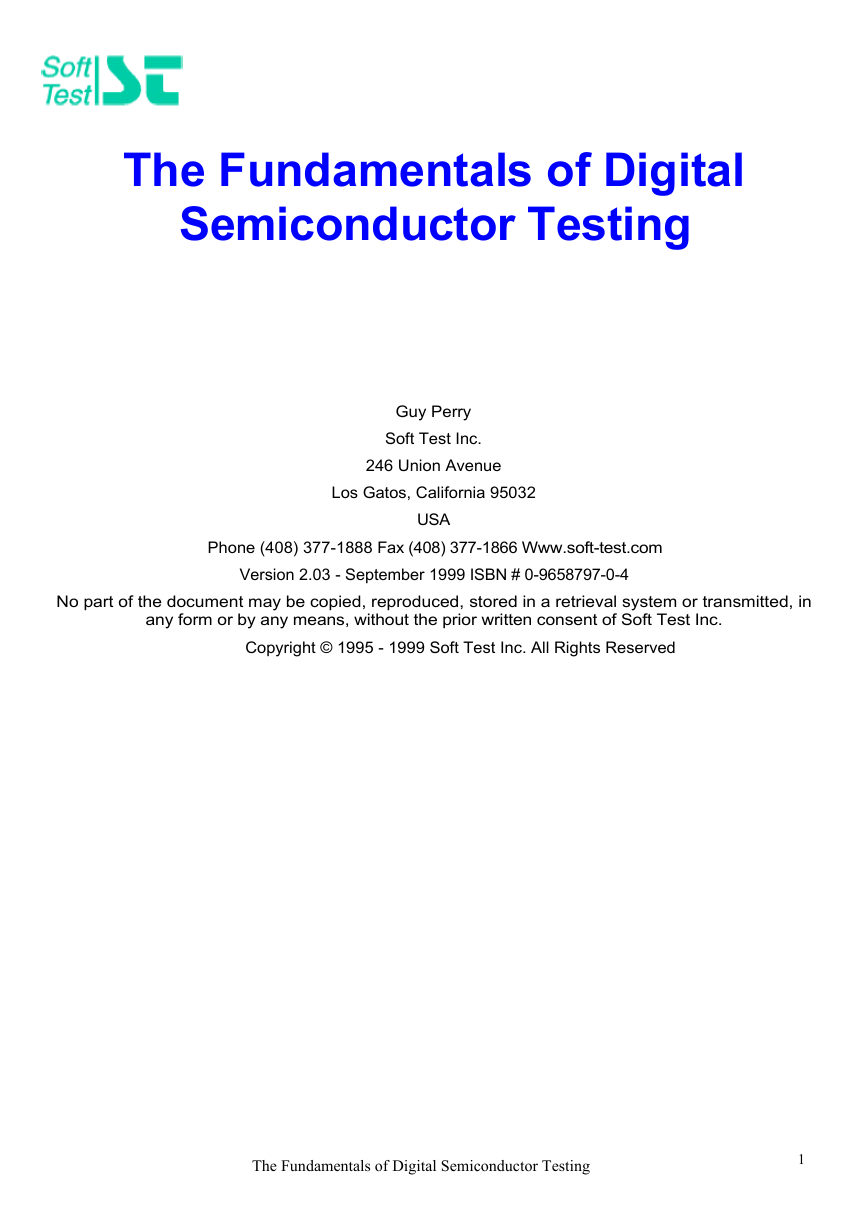
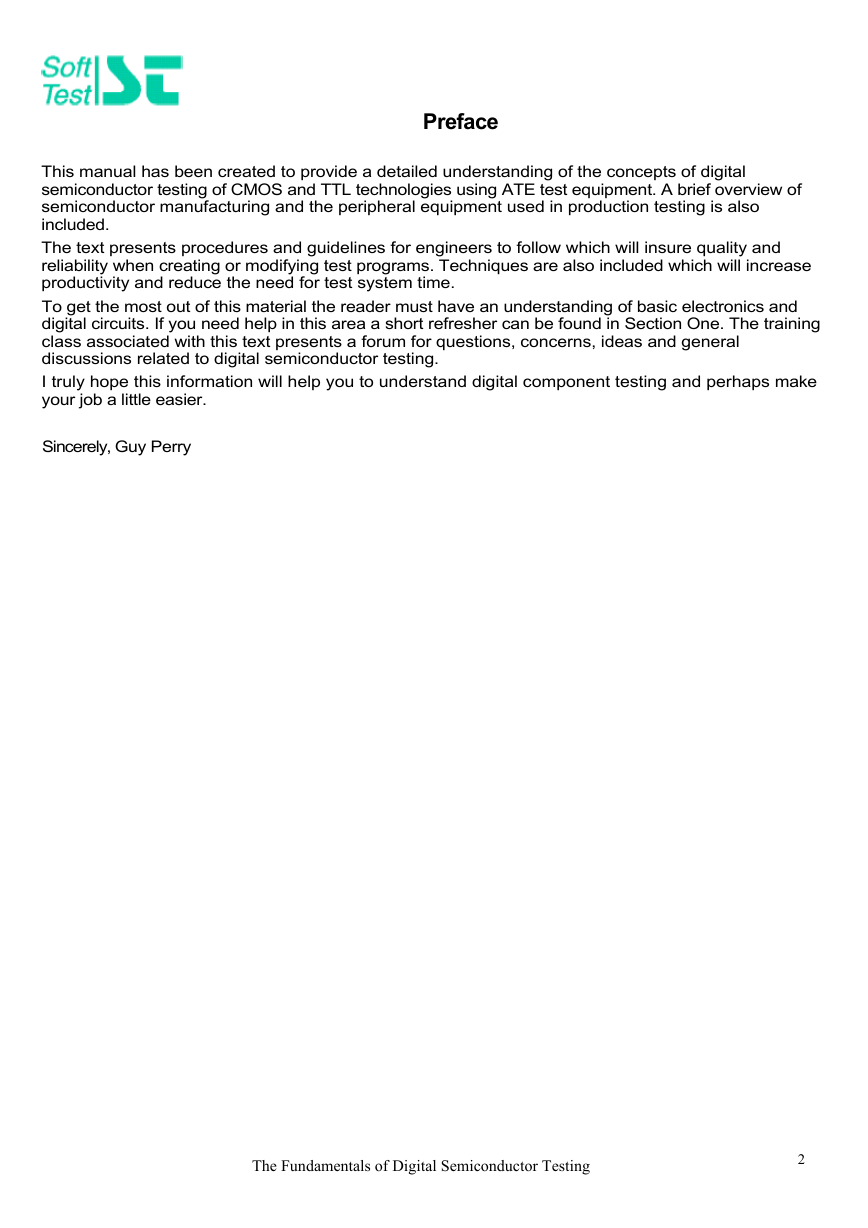
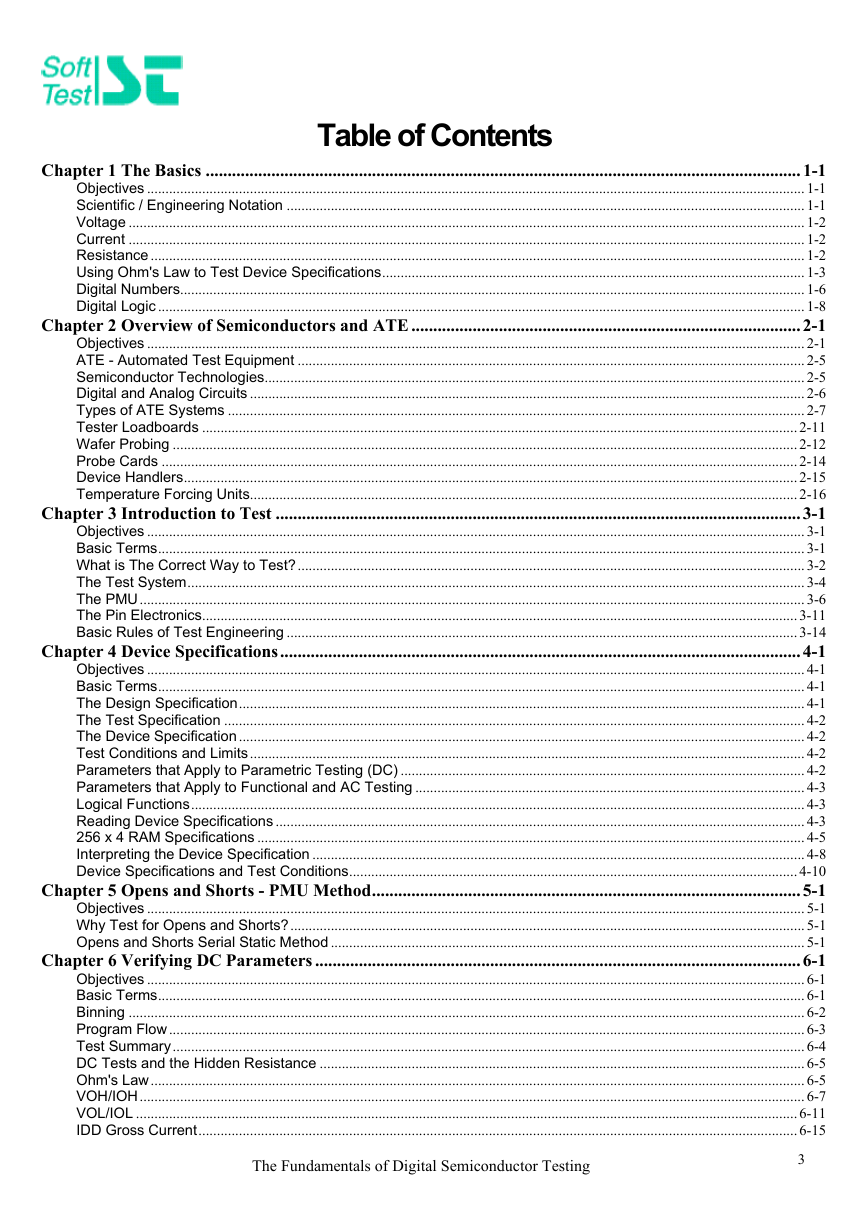
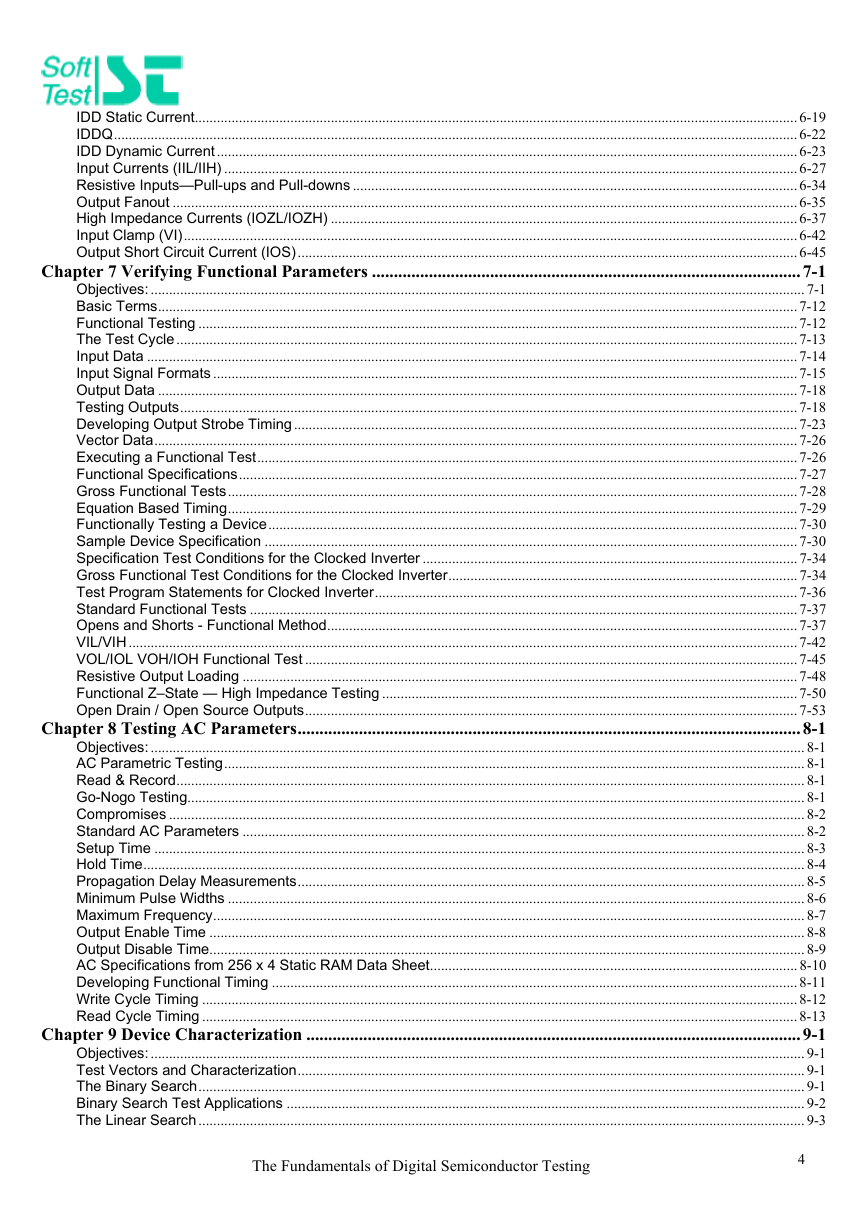
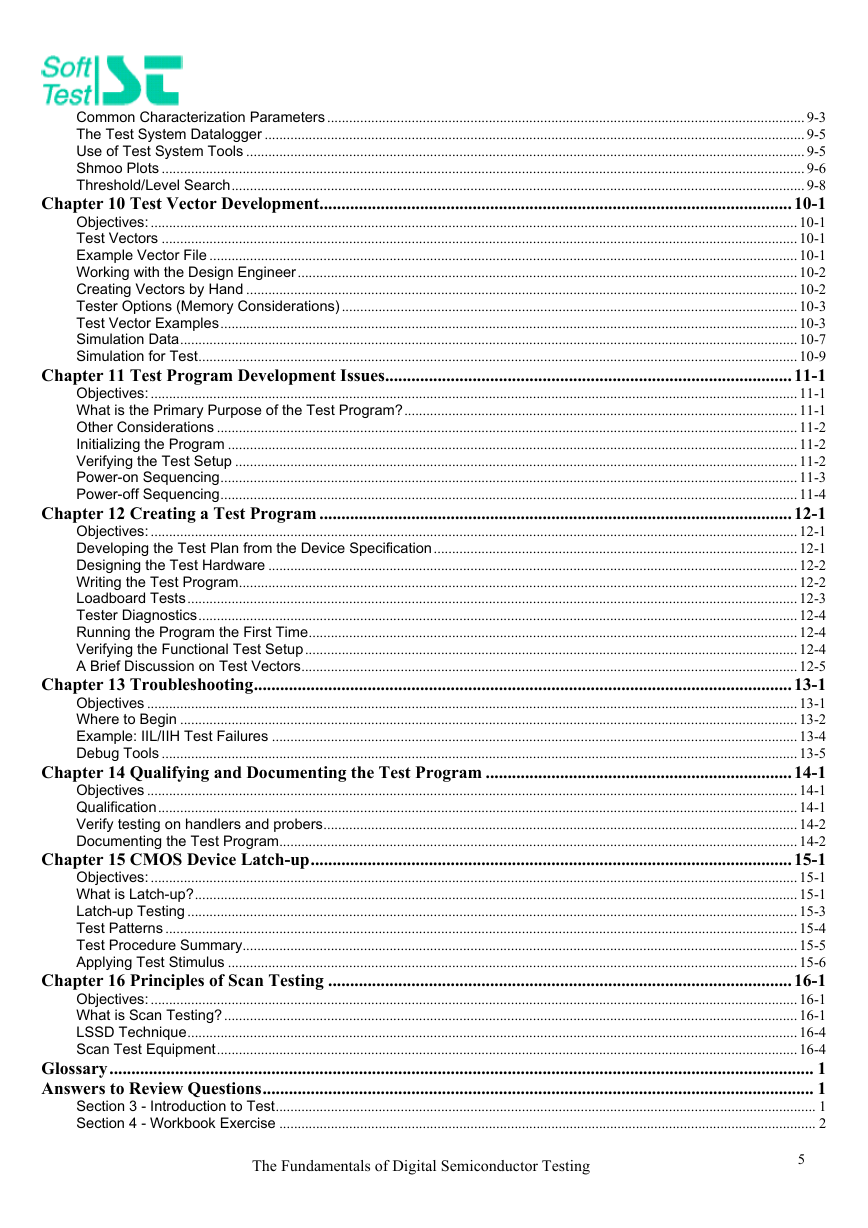

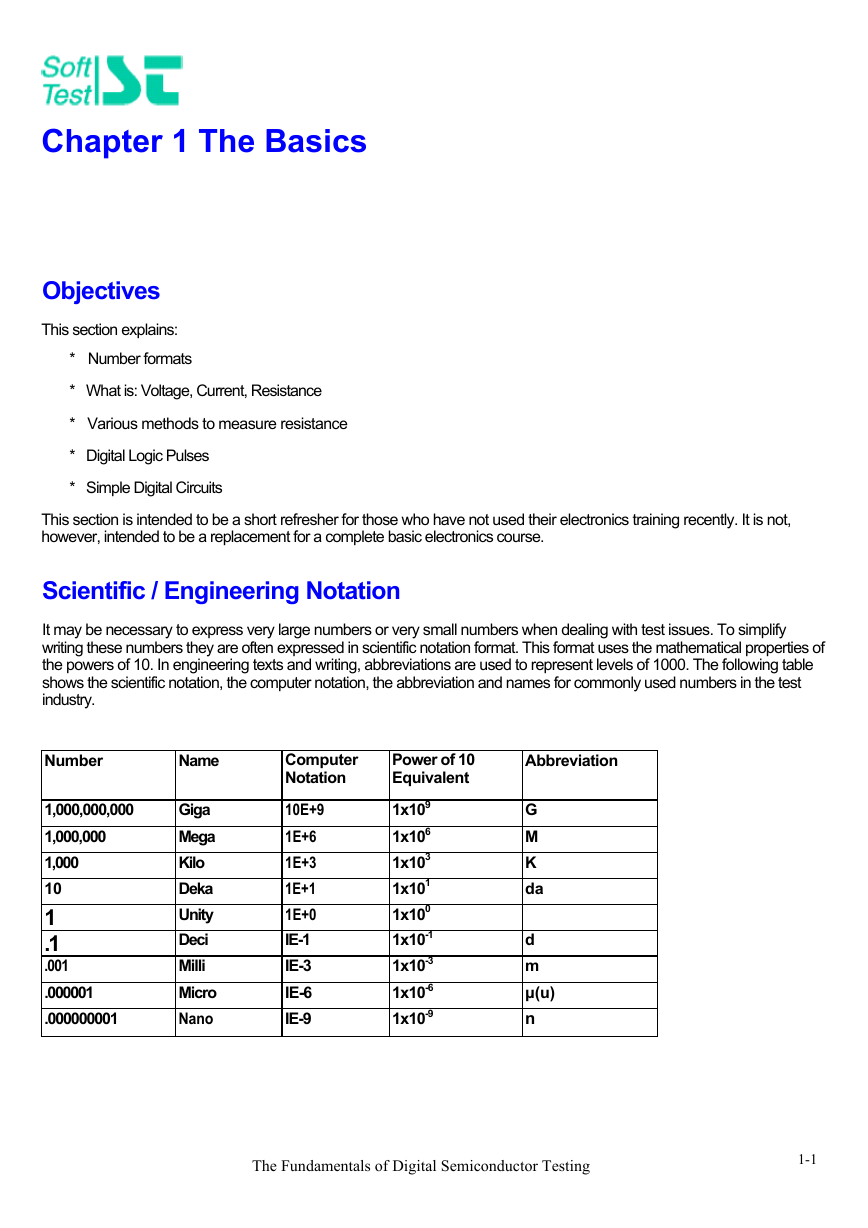
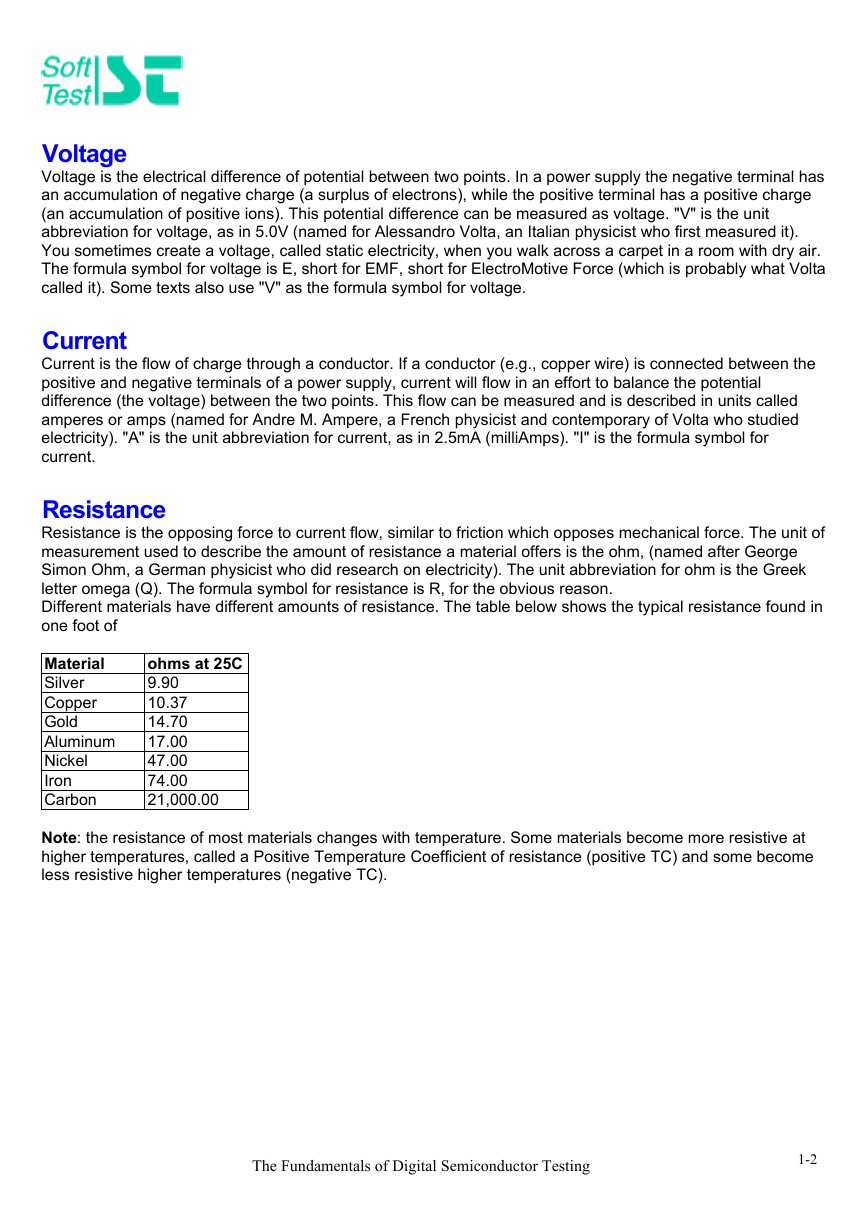








 2023年江西萍乡中考道德与法治真题及答案.doc
2023年江西萍乡中考道德与法治真题及答案.doc 2012年重庆南川中考生物真题及答案.doc
2012年重庆南川中考生物真题及答案.doc 2013年江西师范大学地理学综合及文艺理论基础考研真题.doc
2013年江西师范大学地理学综合及文艺理论基础考研真题.doc 2020年四川甘孜小升初语文真题及答案I卷.doc
2020年四川甘孜小升初语文真题及答案I卷.doc 2020年注册岩土工程师专业基础考试真题及答案.doc
2020年注册岩土工程师专业基础考试真题及答案.doc 2023-2024学年福建省厦门市九年级上学期数学月考试题及答案.doc
2023-2024学年福建省厦门市九年级上学期数学月考试题及答案.doc 2021-2022学年辽宁省沈阳市大东区九年级上学期语文期末试题及答案.doc
2021-2022学年辽宁省沈阳市大东区九年级上学期语文期末试题及答案.doc 2022-2023学年北京东城区初三第一学期物理期末试卷及答案.doc
2022-2023学年北京东城区初三第一学期物理期末试卷及答案.doc 2018上半年江西教师资格初中地理学科知识与教学能力真题及答案.doc
2018上半年江西教师资格初中地理学科知识与教学能力真题及答案.doc 2012年河北国家公务员申论考试真题及答案-省级.doc
2012年河北国家公务员申论考试真题及答案-省级.doc 2020-2021学年江苏省扬州市江都区邵樊片九年级上学期数学第一次质量检测试题及答案.doc
2020-2021学年江苏省扬州市江都区邵樊片九年级上学期数学第一次质量检测试题及答案.doc 2022下半年黑龙江教师资格证中学综合素质真题及答案.doc
2022下半年黑龙江教师资格证中学综合素质真题及答案.doc